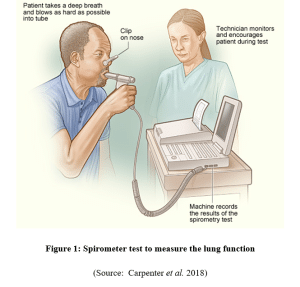Respiratory Physiology Mini Essay Sample
Here’s the best sample of Respiratory Physiology Mini Essay, written by the expert.
Introduction
The thesis statement of this essay is to discuss the usefulness of the spirometer which is effectively required in terms of measuring lung function. Along with this, this study also includes the detailed process of spirometry measurement that is typically used for COPD and restrictive pulmonary disorder.
Main body
Using a spirometer to determine a patient’s lung function
Spirometry is a very common test that is respectively used in terms of assessing the way lungs work through measuring the quantity of air inhaled as well as how much quantity of air is exhaled quickly.

The above figure can help to illustrate the process of the spirometer test which is utilized to measure the ultimate volume of air expired and inspired by the lungs by breathing into a form of a mouthpiece. As per the suggestion of Carpenter et al. (2018), a spirometer can effectively be helpful to measure minimum “three or four lung volumes”, “expiratory reserve volume”, “tidal volume”, “inspiratory reserve volume” but not detect “residual volume” (Ncbi.nlm.nih.gov.2018). The apparatus is used for spirometry tests to monitor and diagnose certain lung conditions in terms of detecting how much air is breathed out of a patient in one forced breath. As opined by Carpenter et al. (2018), a spirometer measures how forcefully a patient can empty air from his lungs. In this case, it is required to collect information from patients such as sex, height and age. Besides that, certain data of patient need to collected which confirmed that they do not smoke for the last few hours before the test, do not taken any heavy meals within the past two hours and have not consumed alcohol within the past four hours.
Process of spirometry measurements used to diagnose a restrictive pulmonary disorder and a chronic obstructive pulmonary disorder (COPD)
In the case of any obstructive lung disease like COPD, several characteristics have changed in spirometry including a decrease in FEV (1) with “vital capacity (FEV (1)/ VC ratio)”. As suggested by Rehman et al. (2019), using spirometry measurement helps to diagnose optimal presence as well as the severity of the airway obstruction of a patient. In this recent era, there have been two vital forms of COPD. For example, “emphysema” ideally involves damage to the lungs over time and “chronic bronchitis” that involve lung dysfunction for long term cough with severe mucus.
A form of restrictive pattern has been characterized as “FVC and FEV1 <LLN accompanied by FEV1/FVC >LLN” (Sharan et al. 2018). In this case, spirometry can suggest a condition of respiratory and state of “restrictive lung disease”. In the case of occupational medicine, spirometry is highly effective regarding periodic evaluation and pre-placement tests. In addition, if a restrictive pattern can be detected by spirometry test, the chosen patient has been referred to an expensive test named “plethysmography”. Some of the well-known examples of “restrictive lung disease” are “pulmonary fibrosis”, “sarcoidosis” and “asbestosis” (Sharan et al. 2018). All the above-mentioned diseases have been characterized by a state of “abnormal inflammatory responses” as well as poor obstruction of “reversible airflow in lungs”.
Conclusion
The entire essay has been concluded about the clinical uses of spirometers to detect the actual state of a lung of a patient. “The pulmonary lung test” measures airflow in the lungs which are useful to evaluate a large-scale of lung disorder. In this case, “vital graphs” are a standard instrument to detect forced expiratory volume per second to diagnose COPD, Asthma and affected breathing issues.
Reference list
Carpenter, D.M., Jurdi, R., Roberts, C.A., Hernandez, M., Horne, R. and Chan, A., 2018. A review of portable electronic spirometers: implications for asthma self-management. Current allergy and asthma reports, 18(10), pp.1-10.
Ncbi.nlm.nih.gov.2018. Pulmonary Function Tests. Available at: https://www.ncbi.nlm.nih.gov/pmc/articles/PMC3229853/
Rehman, A., Shafiq, H., Jawed, S. and Behram, F., 2019. Chronic Obstructive Pulmonary Disease (COPD) Screening is Still a Challenge in Pakistan: COPD in Pakistan. Journal of Aziz Fatimah Medical & Dental College, 1(1), pp.18-23.
Sharan, R.V., Abeyratne, U.R., Swarnkar, V.R., Claxton, S., Hukins, C. and Porter, P., 2018. Predicting spirometry readings using cough sound features and regression. Physiological measurement, 39(9), p.095001.
________________________________________________________________________________
Know more about UniqueSubmission’s other writing services:

